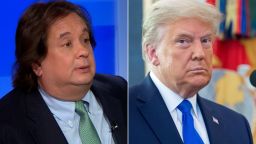Editor’s Note: Frida Ghitis, (@fridaghitis) a former CNN producer and correspondent, is a world affairs columnist. She is a frequent opinion contributor to CNN, a contributing columnist to The Washington Post and a columnist for World Politics Review. The views expressed in this commentary are her own. View more opinion on CNN.
Former President Donald Trump did not fiddle while the US Capitol was under siege. Unlike Nero while Rome burned, Trump did not ignore the conflagration, he tended the fire. He threw social media firebombs; he aimed a firehose of rhetorical gasoline at the flames. That’s the inevitable conclusion of Thursday’s prime time hearing of the House select committee investigating the January 6 assault on the Capitol.

Some had predicted this hearing would prove Trump was guilty of dereliction of duty. But the witnesses – both former staffers in Trump’s White House – showed more than that. Their testimony, along with recordings of other high-level officials’ recollections, provided evidence of how the former president, desperate to overturn the result of the election he lost, was an active, if indirect, participant in the January 6 effort to stop the certification of Joe Biden’s victory in the 2020 presidential election.
This is crucial for many reasons, chief among them creating a documented record for posterity, helping to clarify what occurred to help forge common ground going forward and protecting the future of American democracy.
More to the point, it is vital to establish Trump’s role because he has all but announced he is running for president in 2024. Attorney General Merrick Garland just reassured the country that “No person is above the law in this country,” vowing to hold accountable those “criminally responsible for trying to overturn” the election.
The Fourteenth Amendment of the Constitution says no one can hold office if they engaged in insurrection after earlier taking an oath to the Constitution. Will this apply to the former president?
The final hearing of July – the committee announced more hearings will be held in September – showed just how far Trump went on January 6.
Committee Chairman Bennie Thompson, who kicked off the session remotely because he had tested positive for Covid-19, previewed what we would hear: a detailed accounting of the time between the start of the riot to the moment when Trump finally told his followers to go home, having spent hours refusing the urgent advice from staffers, family and friends to do it sooner and in no uncertain terms. “For 187 minutes on Jan. 6,” Thompson declared, “this man of unbridled destructive energy could not be moved.
Remarkably, after a brief opening statement, Thompson, a Mississippi Democrat, handed the gavel to Rep. Liz Cheney, a Wyoming Republican, to lead the session.
Committee members Elaine Luria, a Virginia Democrat, and Adam Kinzinger, an Illinois Republican, questioned witnesses Matthew Pottinger, a former Trump deputy national security adviser, and Sarah Matthews, a former Trump deputy press secretary. He is a respected national security figure; she a loyal Trump staffer and Republican communications professional. They both decided to resign on January 6, having watched Trump’s inexcusable response to the insurrection.
Another witness, a National Security Council official working in the White House on January 6, testified anonymously, with the individual’s voice distorted to preserve anonymity. That testimony, along with audio of communications by then-Vice President Mike Pence’s security detail, was some of the most chilling testimony we’ve heard.
With the mob shouting “Hang Mike Pence” and looking for Pence in the Capitol, Trump inflamed them further with a tweet calling Pence a coward for refusing to block the election certification. “He put a target on his own vice president’s back,” said Luria, and Pence’s security feared for their own lives.
“There were calls to say goodbye to family members,” testified the unnamed national security professional.
The Capitol was under brutal siege. And Trump was watching it all on television. His aides, one by one, were urging him to tell his supporters to go home. But he refused. While members of Congress hid, while Capitol police officers were getting battered with flagpoles, choked with bear repellent spray, crushed by the swarming mobs, Trump kept watching Fox News and making phone calls to Rudy Giuliani and US senators, still trying to prevent the election certification. One of those senators, Alabama Republican Tommy Tuberville, later described having to get off the phone with Trump to evacuate ahead of the mob.
According to recorded testimony played Thursday, White House counsel Pat Cipollone told him to call them off. So did Chief of Staff Mark Meadows, Cipollone recounted in taped testimony. According to his testimony and text messages shown by the committee, daughter Ivanka and son Donald Jr. Trump joined with the plea, as did Trump’s favorite Fox News stars and others. To no avail.
After training the mob’s attention on his own vice president, the most Trump did was send a couple of mild tweets telling his backers to respect the police. He told them to be peaceful, but Matthews testified that her boss, White House press secretary Kayleigh McEnany, told her the President had resisted mentioning “peace.” Video of the rioters inside the Capitol showed them reviewing Trump’s message on their phones. He wants us to respect the police, they said, but noted that he had said nothing about leaving the Capitol or not hurting members of Congress.
Gen. Mark Milley, the country’s top military chief, described his reaction. On tape we heard him say, “You’re the Commander in Chief. You’ve got an assault going on the Capitol of the United States of America, and there’s nothing? No call? Nothing? Zero?”
The mob, shouting “Fight for Trump!”, was doing his work – they were pursuing Trump’s stated objectives. That’s why he wouldn’t stop them. That’s why even after the election was certified in the early hours of January 7, Trump still couldn’t bring himself to say the words “the election is over” in a recorded address to the nation.
Finally, 187 minutes after the assault started, after the chronology showed that Trump saw on Fox News that the National Guard was on its way, Trump went to the Rose Garden and recorded a message to his supporters. It was another appalling moment. “Go home,” he told them. “We love you. You’re very special.” But he never stopped his campaign to overturn the election. His message started, “I know your pain. I know you’re hurt. We had an election stolen from us. It was landslide election, and everyone knows it.” That, of course, is a lie. And it’s a lie he continues to tell to this day.
Trump knew for more than three hours that the Capitol was under assault. He knew some of the rioters were armed. He knew they were threatening to kill Pence. He didn’t just allow it to happen, he watched actively – tweeting, phoning, resisting entreaties to intervene.
When Trump told them to leave, they started passing the word. We heard the audio and watched the video. They were following their leader’s instructions. Trump was not able to go to the Capitol, but he had a great deal of control over his followers.
January 6 was Trump’s insurrection. He should be held accountable for it.







